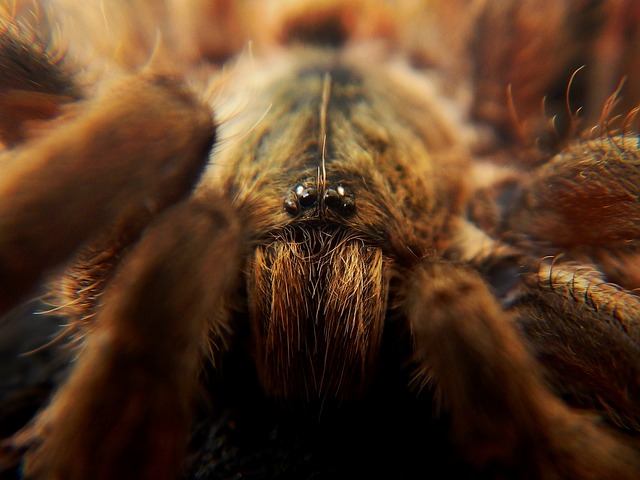Many tarantula owners wonder if they can house multiple spiders together. Tarantulas are solitary creatures by nature and often exhibit cannibalistic behavior. This article will explore the risks and rare exceptions for keeping tarantulas in shared enclosures.
Are you ready to learn about tarantula cohabitation?
General Behavior of Tarantulas in Captivity
Tarantulas in captivity often display strong territorial instincts. They prefer solitude and may react aggressively to other spiders in their space.
Territorial nature
Tarantulas are fiercely territorial creatures. They stake out their living spaces and defend them against intruders. They will exhibit aggression even towards spiders of the same species.
This territorial instinct is deeply ingrained, making it risky to house multiple tarantulas together in captivity.
A tarantula’s enclosure is its kingdom, and it will fight to protect it.
Female and male tarantulas exhibit similar territorial behaviors, although males often leave their shelters in search of a mate after reaching adulthood and tend to be less defensive.
Cannibalistic tendencies
Tarantulas have a dark side: they sometimes eat each other. This behavior, called cannibalism, isn’t rare in the spider world. Female tarantulas may devour males after mating. In one study, this happened in over half the observed cases.
Sexual cannibalism brings benefits to female tarantulas. In difficult seasonal conditions when food is scarce, this behavior allows them to obtain the necessary nutrients to produce an egg sac. But for males, it’s a different story.
In nature, this behavior is very common not only in the spider world. It is not limited to mating; it is a deeply ingrained trait resulting from evolution and their natural conditions. The risk of keeping tarantulas together is significant due to these cannibalistic tendencies.
Conditions for Cohabitation
Certain tarantula species can live together peacefully. Communal setups work best with spiderlings from the same egg sack, like Monocentropus balfouri or Poecilotheria metallica.
Communal species and setup
Tarantula enthusiasts often explore communal setups with specific species known for their social tendencies. Monocentropus balfouri, Hysterocrates gigas, and Poecilotheria metallica stand out as prime candidates for shared enclosures.
These species exhibit greater tolerance for cohabitation, especially when introduced as spiderlings from the same egg sac. Successful communal housing requires careful monitoring. A common logical mistake made by novice enthusiasts is providing too large a container, which in group housing triggers territorial behaviors.
Such a container for group housing should be of a size that prevents the spiders from creating separate hiding spots. Instead, they should have one common hiding place, such as a small tube. It shouldn’t be too small, allowing the spiders some room to move, but it also shouldn’t be too large, as they need to maintain constant contact with each other.
The arrangement of the container is crucial to minimizing the risk of cannibalism, but it is also important to ensure abundant feeding. Each feeding, there should be at least 2 insects per spider in the container. For this purpose, we should use Turkish cockroaches, as they do not burrow into the substrate and remain in constant motion, ensuring that all are eaten and thereby reducing the risk of tarantula cannibalism.
The container housing a significant group of spiders should also be cleaned more frequently. A common practice among breeders to save time is to transfer the mentioned cork tube with the spiders inside it to a second clean container instead of picking out each piece of debris from the substrate.
Monocentropus balfouri communal keeping
This tarantula species is unique in the tarantula world due to its origin and the conditions of its native habitat, as well as its incredible appearance.
Its uniqueness is also evident in that it is the only species that can be kept in a group without any concerns about cannibalism. What’s more, the entire group can hunt together and share food. The young, left with the mother, will be fed by her; they climb up to her mouth where a previously caught insect awaits them – truly amazing.
Every experienced tarantula breeder and seller keeps them this way to save money, space, and time. Due to the relatively low humidity requirements of these tarantulas, there is also no need to clean up food remnants.
Risks of Housing Tarantulas Together
Housing tarantulas together can lead to deadly fights. These spiders may attack and eat each other, even if they’re the same species.
Potential for aggression and cannibalism
Even after meeting the aforementioned requirements for successful communal housing, losses will still occur. These losses can be attributed to natural cannibalism or the weakness of some individuals, who may be eaten by others or perish on their own.
Caring for spiders housed individually is easier, with each spider receiving its own food and attention. However, in communal housing, keepers quickly notice that spiders grow faster and hunt more eagerly, and they are less prone to stress.
The potential losses in profit are offset by the efficiency of managing such a communal enclosure and the reduced space it requires.
Conclusion
Housing tarantulas together is risky business. These arachnids prefer solitude and may turn aggressive if forced to share space. While some species show communal tendencies, it’s rare and often unpredictable.
For the safety and well-being of your eight-legged friends, separate enclosures remain the best choice. Experienced keepers might attempt cohabitation for breeding purposes, but close monitoring is crucial to prevent harm.
FAQs
1. Will tarantulas fight each other?
Tarantulas are defensive and territorial animals, and they will fight for their space. Another tarantula represents a potential threat or food source.
2. Do tarantulas live alone or in groups?
In nature, spiders always live solitary lives. In captivity, however, some species can tolerate being kept together in the same terrarium.
3. Are there any exceptions to keeping tarantulas separate?
Except for the species Monocentropus balfouri, even species that can tolerate cohabitation in the one enclosure may still experience losses due to inherent cannibalistic behaviors.
4. What kind of tarantulas can live together?
5.Can jumping spiders and tarantulas live together?
This is possible if we prepare a very large tank and choose a tarantula that is also quite large, so it won’t be interested in hunting a very small and difficult-to-catch jumping spider.







